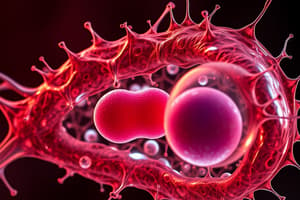Podcast
Questions and Answers
Which organelle contains digestive enzymes such as lipases, nucleases, and proteases?
Which organelle contains digestive enzymes such as lipases, nucleases, and proteases?
- Golgi apparatus
- Nucleus
- Endoplasmic reticulum
- Lysosomes (correct)
What is the tissue half-life of Lactic Acid Dehydrogenase in the heart?
What is the tissue half-life of Lactic Acid Dehydrogenase in the heart?
- 1.6 days (correct)
- 16 days
- 48 hours
- 31 days
Which proteins have a short half-life and include regulatory proteins and enzymes that catalyze committed steps?
Which proteins have a short half-life and include regulatory proteins and enzymes that catalyze committed steps?
- Regulatory proteins (correct)
- Long-lived proteins
- Structural proteins
- Special cases
In which compartment does protein degradation occur through the ubiquitin-dependent proteasome system?
In which compartment does protein degradation occur through the ubiquitin-dependent proteasome system?
What is responsible for the breakdown of most short-lived proteins in human cells?
What is responsible for the breakdown of most short-lived proteins in human cells?
How are proteins selected for degradation?
How are proteins selected for degradation?
Which enzyme catalyzes the transfer of ubiquitin from E2 to a Lysine amino group of the protein destined for degradation?
Which enzyme catalyzes the transfer of ubiquitin from E2 to a Lysine amino group of the protein destined for degradation?
What is the function of the 19S regulatory particle in the proteasome?
What is the function of the 19S regulatory particle in the proteasome?
What determines the protein function by monoubiquitinating some proteins?
What determines the protein function by monoubiquitinating some proteins?
What is the minimum number of ubiquitin molecules critical for efficient degradation of a protein?
What is the minimum number of ubiquitin molecules critical for efficient degradation of a protein?
Which enzyme family can reverse the degradation effects by cleaving the bond between ubiquitin and its substrate protein?
Which enzyme family can reverse the degradation effects by cleaving the bond between ubiquitin and its substrate protein?
Explain the process of protein degradation through the ubiquitin-proteasome system, including the role of ubiquitin and the proteasome components.
Explain the process of protein degradation through the ubiquitin-proteasome system, including the role of ubiquitin and the proteasome components.
Describe the role of deubiquitinating enzymes (DUBs) in the ubiquitin-proteasome system.
Describe the role of deubiquitinating enzymes (DUBs) in the ubiquitin-proteasome system.
What are the major biological events controlled by the proteasomal pathway?
What are the major biological events controlled by the proteasomal pathway?
Explain the role of the 19S regulatory particle in the 26S proteasome.
Explain the role of the 19S regulatory particle in the 26S proteasome.
What is the function of ubiquitin in the process of protein degradation?
What is the function of ubiquitin in the process of protein degradation?
Study Notes
Intracellular Protein Degradation
- Intracellular protein degradation is essential for maintaining a constant supply of amino acids and preventing the accumulation of abnormal proteins within the cell.
Protein Turnover
- Protein turnover is not constant and varies greatly among individual proteins, reflecting their role within the cell.
- Half-lives of proteins range from: • 100-200 hours for "normally" proteins • Short-lived proteins (regulatory proteins, enzymes, and transcription factors) • Long-lived proteins (structural proteins and crystallins)
- Tissue distribution affects protein degradation rates, as exemplified by Lactic Acid Dehydrogenase: • Heart: 1.6 days • Muscle: 31 days • Liver: 16 days
Regulation of Protein Degradation
- Protein degradation is a regulated process, influenced by factors such as nutritional state.
- Example: Acetyl CoA carboxylase has a half-life of: • 48 hours when fed • 18 hours when fasted
Compartments of Protein Degradation
- Protein degradation occurs in two main compartments:
• Lysosomes (10-20%): acidic compartment containing digestive enzymes (lipases, nucleases, proteases), responsible for degrading:
- Extracellular proteins
- Some intracellular proteins • Cytosol (80-90%): ubiquitin-dependent proteasome system, responsible for degrading most intracellular proteins.
Studying That Suits You
Use AI to generate personalized quizzes and flashcards to suit your learning preferences.
Description
Test your knowledge of intracellular protein degradation with this overview quiz. Learn about the process, its importance for the cell, and the variation in protein half-life.




